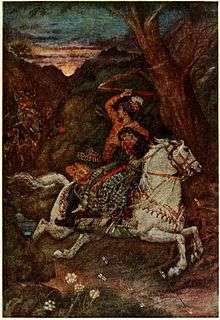Danava (Hinduism)

In Vedic mythology the Danavas (Balinese Hinduism Dewi Danu) were a race descending from Daksha.
The Danavas were the sons of Danu, who in turn was a daughter of Daksha. Danu is connected with the waters of heavens and she is probably associated with the formless, primordial waters that existed prior to the creation. The name is connected with the PIE root *danu, "river" or "any flowing liquid" and is associated with the Danu (Asura). Under the leadership of Bali.[1] and others the Danavas revolted against the Devatas (Devas).[2] Despite initial successes, the Danava were defeated by the god Vamana who in dwarf form deceived their leader Bali.[3] The Danavas were not universally considered to be evil, individual Danava could be classified as good or bad.
Europe
David Frawley asserts that many ancient European peoples, particularly the Celts and Germans, regarded themselves as children of Danu, with Danu meaning the Mother Goddess, who was also, like Sarasvati in the Rig Veda, a river Goddess. The Irish Celts called their gods Tuatha De Danaan, while the Germans had a similar name. The Greek ethnonym 'Danaan' is similarly related.[4]
Historical basis
Some argue for an historical basis for the Vedic stories, and that the Danavas, and other defeated beings (Rakshasas, Gandharvas, Nagas, et cetera) were non-Aryan tribes, or that the Danavas in the Mahabharata, whose story is set in the region of the larger Indus river system, represent the Indus Valley Civilization, the builders of Mohenjo Daro and Harappa.[5][6] But such historical readings of myth and legend are fraught with difficulties, and often are made selectively in support of pre-existing historical theories. There continues to be controversy over the idea of an Indo-European/Aryan invasion of India in some circles, and rival interpretations of Indian myth are one of the battlegrounds of that debate.[6][7][8]
See also
- Bhagavata Purana
- Denyen
- Daityas
- Tribe of Dan
- Exotic tribes of ancient India
- Kalakeyas
- Kukulkan
- Tuatha Dé Danann
- List of Asuras
- Nāga
- Nagaland
- Naga people
- Nivatakavacha
Notes
- ↑ Rose, Carol (2000) Giants, Monsters, and Dragons: An Encyclopedia of Folklore, Legend, and Myth ABC-CLIO, Santa Barbara, CA, p. 94 ISBN 0-87436-988-6;
- ↑ Monro, W. D. (1911). Stories of Indian Gods & Heroes. London: Harrap (Unwin). p. ?.
- ↑ Williams, George Mason (2003). Handbook of Hindu Mythology. Santa Barbara, California: ABC-CLIO. p. 73. ISBN 978-1-57607-106-9.
- ↑ Frawley, David (1997). "Vedic Origins of Europeans: The Children of Danu". In Mallory, J. P.; Adams, Douglas Q. Encyclopedia of Indo-European Culture. London: Fitzroy Dearborn. p. 232. ISBN 978-1-884964-98-5.
- ↑ Senoupta, Prabodh Chandra (1951) "The Dānavas in the Mahābhārata" Journal of the Asiatic Society Series 3, 17: pp. 177-184, p. 182
- 1 2 Frawley, David (2001). Rig Veda and the History of India. New Delhi: Aditya Prakashan. ISBN 978-81-7742-039-5.
- ↑ Elst, Koenraad (1999) Update on the Aryan Invasion Debate Aditya Prakashan, New Delhi, ISBN 81-86471-77-4 ;
- ↑ Frawley, David (1991) Gods, Sages and Kings Passage Press, Salt Lake City, Utah, ISBN 1-878423-08-8 ;